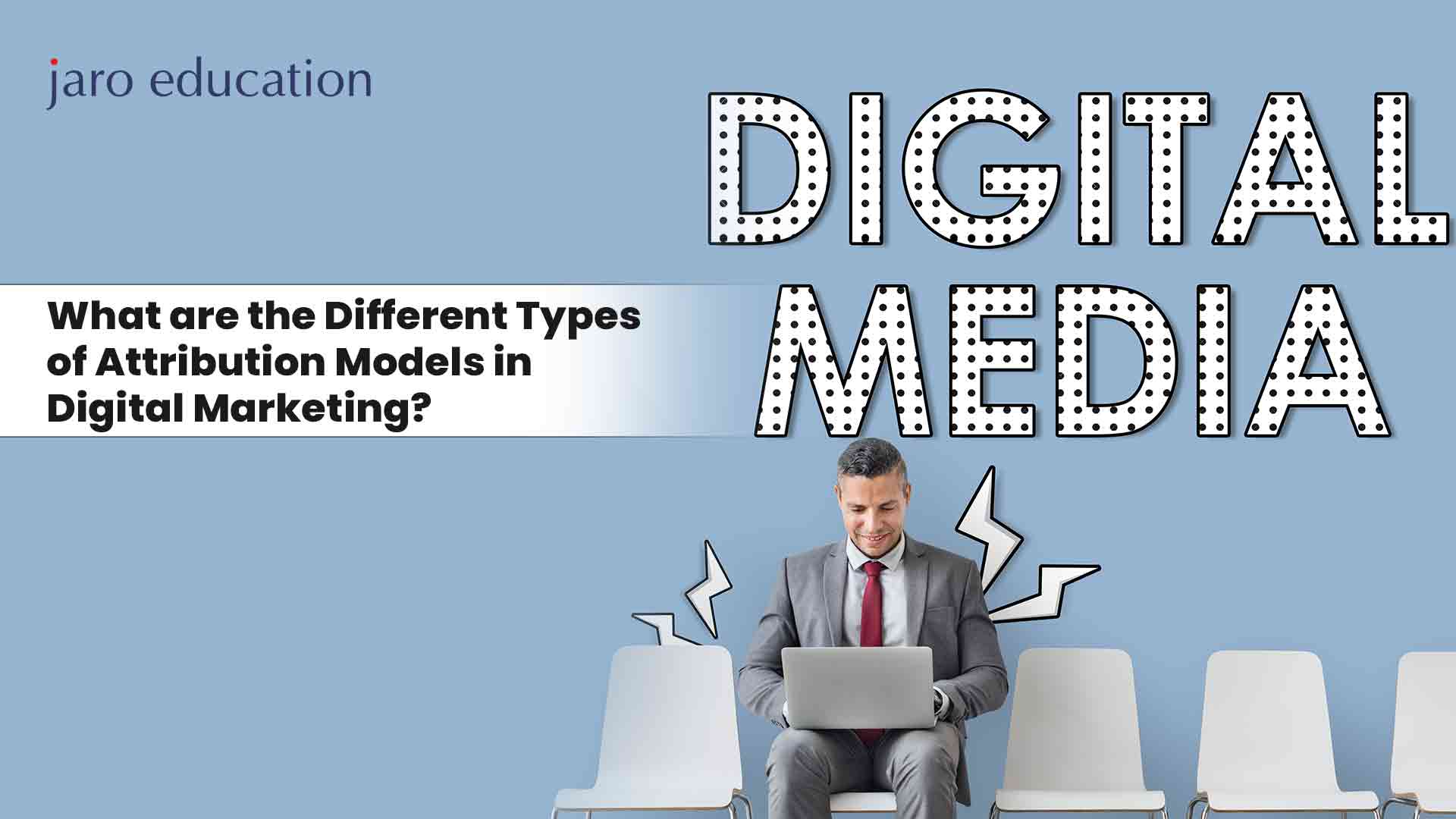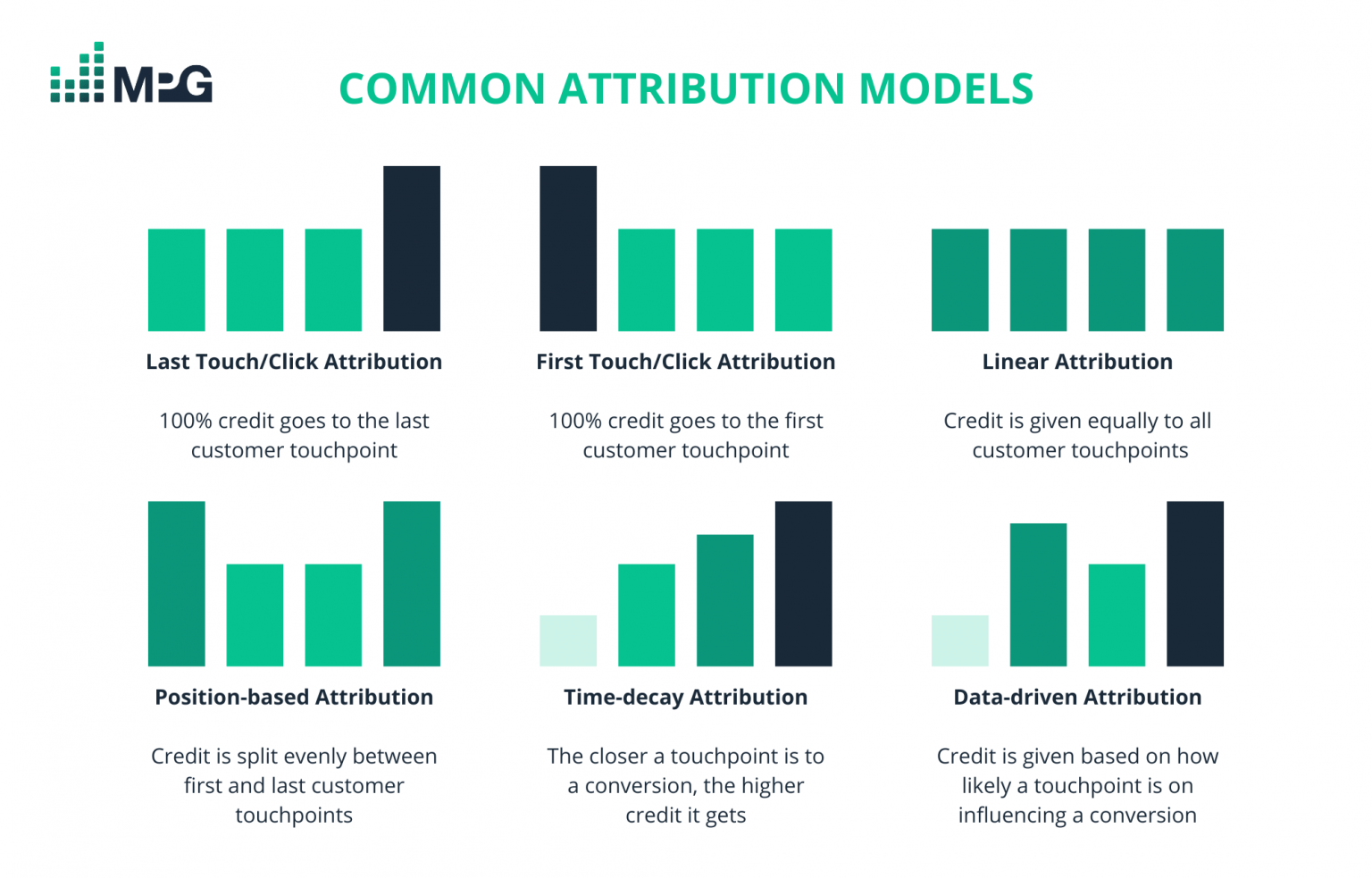What are the Different Types of Attribution Models in Digital Marketing
Table of Contents

- jaro education
- 26, February 2024
- 10:00 am
Throughout the history of marketing, businesses have always aimed to find reliable methods for gauging the effectiveness of their strategies. This is where marketing attribution models come into the picture. Attribution models have revolutionized the way marketers approach their campaigns by offering a method to identify key touchpoints in the customer journey.
By attributing conversions to specific marketing channels, businesses gain valuable insights into what drives success. This enables marketers to optimize their strategies, concentrating their efforts on channels and tactics that deliver the highest return on investment (ROI). This blog will give you a detailed explanation regarding attribution models, providing clear examples and visual aids to help you comprehend when and how to effectively use each one.
What is the Attribution Model?
An essential lesson for marketers is to avoid relying solely on one strategy. Diversifying and promoting through various channels is crucial, engaging different lead sources. Building a customer journey involves creating multiple interaction points between potential leads and your product or service. However, for those without the vast resources of a Fortune 500 company, budget constraints limit the ability to invest significantly across all channels and touchpoints. It’s imperative to recognize where the majority of your customers originate and optimize marketing efforts accordingly.
Attribution modeling, according to Google, is the set of rules determining how credit for sales and conversions is assigned to different touchpoints in conversion paths. In simpler terms, it helps attribute conversions to specific channels, grading marketing channels and touchpoints within the buyer’s journey, whether it’s a Facebook ad, a follow-up email, or an influencer’s TikTok post.
Importance of Attribution Model
Digital marketing relies on attribution models as a framework for assessing and evaluating performance, allowing marketing teams to identify the most effective strategies for generating leads at various stages of the sales funnel. The success of marketing campaigns is built upon the insights gained from past experiences.
Thanks to attribution models, marketers can:
- Assess the effectiveness of channels and touchpoints, estimate returns on investment (ROIs), and measure key metrics.
- Optimize budget allocation by directing funds to the most successful marketing efforts.
- Develop a deeper understanding of the buyer’s journey, pinpointing areas for improvement.
- Create and implement targeted marketing campaigns tailored to specific buyer personas and their journeys.
Types of Attribution Models
There isn’t a universal solution or a standard marketing attribution model that suits every individual or campaign. Various attribution model types exist, employing distinct logic and methods to allocate credit or conversion value across different touchpoints. We will explore these models using examples.
First-Interaction Attribution Model
As the name implies, this approach attributes full recognition to the initial interaction or first click a customer makes before completing a conversion. Consider a scenario where you operate a business specializing in eco-friendly and sustainable clothing. A customer encounters your Google ad when searching for eco-friendly clothing nearby, clicks on it, explores your website, and departs. Weeks later, they rediscover your brand on Pinterest, visit your website, and ultimately make a purchase. According to the first-interaction attribution model, the Google ad receives full credit, representing the entire value of the initial interaction.
This model aids marketers in discerning the most effective channels for introducing and generating awareness of their product or service. It is particularly beneficial for businesses with extended sales cycles that prioritize building enduring relationships with clients, fostering customer loyalty, and cultivating brand advocates.
Advantages:
- Opting for the initial interaction attribution model proves advantageous when aiming to monitor the duration users require to convert through various channels.
- This can prove valuable, particularly if your company utilizes an internal CRM system and seeks insights into the time it took for individuals to convert after engaging with Facebook advertisements.
Disadvantages:
The accuracy of the first interaction model diminishes as it neglects to consider the user’s origin before the conversion event.
Final-Interaction Attribution Model
This model serves as the counterpart to the initial-touch attribution model. It attributes credit to the ultimate touchpoint that a potential customer engages with just before completing a conversion. Widely encountered, particularly in tools like Google Analytics, this attribution model is particularly useful for analyzing brief sales cycles characterized by fewer touchpoints. In such cases, the first touchpoint frequently coincides with both the last interaction and the conversion action.
Advantages:
- Effective for analyzing the customer journey.
- Helpful in identifying the user’s final click before conversion and assessing conversion time at each process point.
- Applicable to all forms of marketing, including paid ads, social media campaigns, and in-house CRM.
Disadvantages:
- Fails to consider the user’s initial brand interaction before conversion.
- Potential misattribution when users interact initially, leave, and return through a different channel.
- May incorrectly attribute the last interaction to a channel like Google instead of the original ad.
- Varied interpretations of “conversion” may lead to inaccuracies.
- Risk of inaccurate data if not cautious, particularly in not accounting for the type of conversion preceding a purchase.
Linear Attribution Model
The linear attribution model emphasizes fairness by allocating equal credit to every channel and touchpoint engaged by the customer throughout the purchasing process. In the given scenario, if a customer viewed your ad on Google, discovered your clothing on Pinterest, encountered a display ad on Instagram weeks later, and subsequently made a purchase, each of these channels—Google, Pinterest, and Instagram—is attributed an equal share of credit.
Although this model may not pinpoint the most impactful marketing channel, it does offer a comprehensive and equitable method for evaluating the customer’s journey.
Advantages:
- The linear attribution model is user-friendly and requires minimal effort, as there’s no need for intricate calculations to determine the contribution of each channel to the conversion.
Disadvantages:
- The primary drawback of the linear attribution model lies in its inaccuracy for many businesses. Conversions are often unevenly distributed among channels, potentially heavily favoring a single channel.
- Using this model might lead to misleading conclusions, such as underestimating the impact of a particular channel. For example, attributing only half of the sales to paid ads when, in reality, they might account for 95% of the conversions.
Last Non Direct Click
In this marketing attribution model, all the credit for a conversion is allocated to a single interaction, similar to the approaches discussed earlier. However, this model excludes any “direct” interactions that occur immediately before a customer completes a conversion.
To illustrate, suppose a customer first discovers your client’s website by clicking on a LinkedIn ad or through organic post clicks in your client’s LinkedIn analytics. They then sign up for your client’s mailing list and start receiving newsletters, clicking on various interesting links.
This customer remains engaged with your client’s newsletters for some time. Several weeks later, they directly visit your client’s website and complete a conversion.
Rather than attributing the conversion credit to direct traffic (i.e., the customer going straight to your client’s website), the last non-click attribution model assigns this value to the email marketing touchpoint.
Thus, this marketing attribution model evaluates which channel prompted a customer to directly visit your client’s website while ensuring a plague-free attribution process.
Advantages:
- Ideal for analyzing the customer journey
- Provides insights into the user’s final click before conversion
- Offers information on the time taken to convert at each stage
- Compatible with various marketing channels, including paid ads, social media campaigns, and in-house CRM
Disadvantages:
- Does not consider the user’s initial interaction with the brand before converting
- Might overlook instances where users initially clicked on an ad but completed their purchase through a different channel, such as a Google search after not finding the desired product initially.
Multi-Touch Attribution Models
Multi-touch attribution models are highly sought-after in the field of marketing attribution. As consumer purchasing behaviors undergo changes and become more diverse, a model capable of monitoring and incorporating all these interactions provides a more accurate representation of the entire purchasing journey.
In essence, a multi-touch attribution model considers every touchpoint encountered during a customer’s conversion journey, offering a comprehensive perspective that reveals more nuanced patterns and behaviors compared to single-touch models.
Thus, it’s crucial to understand that the primary objective of multi-touch attribution extends beyond mapping customer interactions. It also serves to identify the touchpoints that exert the most influence on customers, the collaborative effects of different touchpoints, and the relative likelihood of channel interactions across various customer paths.
Time Decay Attribution
Time decay attribution allocates attribution credits in an incremental manner. In this approach, each touchpoint is progressively assigned greater credit, where the initial touchpoint receives the least credit, and the final touchpoint garners the highest. This proves to be a valuable method for delineating a customer’s journey to conversion.
The underlying assumption of this model is that touchpoints in closer proximity to the conversion exert a more significant influence than those occurring farther away from the conversion.
Suppose a customer engaged with your company via an advertisement and subsequently through organic search before making a conversion. In this attribution model, the distribution would indicate 25% for ads and 75% for organic, with the latter being the most recent interaction.
As you can see, digital marketing does not stick to one platform such as Google or Instagram. It is vast, and your digital presence on all platforms makes a huge impact. To understand the whole spectrum of digital marketing and how each platform serves to gain traffic, you should consider Digital Marketing: Business Models, Processes, and Technologies from IIM Ahmedabad.
Advantages:
- Considers the timing of user conversions.
- Allows tracking of conversions attributed to each channel from a single user.
- Useful for identifying the effectiveness of channels in converting users who initially clicked on paid ads and later engaged with the brand before returning for further interaction.
Disadvantages:
- More complex compared to the linear model.
- The complexity arises from accounting for the timing of conversions.
- This may pose challenges in implementation and understanding for some users.
U Shaped Attribution Model
Attribution in a U-shaped model involves distributing credit to all touchpoints, with a particular emphasis on assigning higher credits to the initial and final interactions. This suggests that the first and last touchpoints in your customer’s journey before reaching a conversion milestone hold greater significance.
W Shaped Attribution Model
W-shaped attribution, much like the U-shaped model previously discussed, emphasizes the significance of both the initial and concluding touchpoints. In this model, the middle touchpoint, if it involves generating high-quality leads during the sales funnel, is considered influential and is accorded equal importance to the first and last touchpoints.
For instance, if there are a total of 5 first touchpoints, each of the first, middle, and last touchpoints is allocated 30% importance, with the remaining touchpoints receiving only 5%.
To illustrate, consider five touchpoints: an advertisement, a blog, a case study, reviews, and a retargeting campaign.
Consider this scenario: a potential customer initially interacts with your business through an advertisement. They later explore your blogs and decide to subscribe to your business’s newsletter, becoming a lead in the middle of the process. This lead stays consistently engaged with your business through newsletters and eventually converts by signing up for a free trial.
Advantages:
- Effective for businesses with multiple touchpoints leading to a conversion.
- Recognizes the significance of various interactions before the final conversion.
Disadvantages:
- Attributes conversion credit to all marketing touchpoints, regardless of their actual impact.
- Risk of diluting conversion credit when there are numerous marketing efforts between the initial and final touchpoints.
Custom Attribution Model
Does your company have specific values for each step in the customer journey or does it follow a particular way to measure success?
In such instances, the implementation of a customized attribution model is worth considering. As the name implies, this marketing attribution model is fully adaptable to align with your organization’s unique goals and insights.
Consider a scenario where your organization boasts a well-established business with a wealth of historical trend data. Utilizing these data-driven insights into the purchasing cycle positions your team to set personalized goals and gain a nuanced understanding of the performance of various marketing channels over time. In this context, a personalized attribution model proves invaluable, providing accurate insights into the effectiveness of your marketing strategies.
Advantages:
- Offers a detailed analysis of channels contributing to the highest conversions.
- Customizable according to client preferences.
Disadvantages:
- Demands a substantial volume of data for precise estimates.
- Requires an in-depth understanding of the conversion landscape.

*mpg.biz
Common Mistakes to Avoid while Implementing Attribution Model
Neglecting Touchpoints:
- Failing to account for touchpoints leading to conversions is a common mistake in marketing attribution.
- Overlooking activities like remarketing and email marketing when evaluating success based on the first click can occur.
Biased ROI Calculation:
- Top-of-the-funnel activities like content marketing might be undervalued if ROI is solely calculated based on the last click.
- This bias can lead to scaling down effective strategies due to incomplete attribution consideration.
Single-Channel Oversight:
- Failing to consider the impact of multiple marketing channels simultaneously is another attribution mistake.
- Isolating one channel may result in missing synergies between different efforts, hindering accurate assessment of channel contributions.
Ignoring Synergy:
- Overlooking synergies between marketing efforts limits the ability to identify channels contributing most to conversions or revenue.
- The inability to adjust spending based on accurate channel contribution assessment can lead to suboptimal budget allocation.
Final thoughts
You can make informed decisions that optimize successful marketing channels and uncover any gaps in the customer journey by evaluating your client’s sales funnel and selecting an attribution model aligned with their goals. Remember to rely on data for recommendations, but also be transparent about any limitations. This approach not only guides your campaign toward marketing success but also highlights the return on investment for your marketing efforts. Keep practicing these key steps and attribution models to ensure that your marketing expertise continues to make impactful and informed contributions to overall company success.








